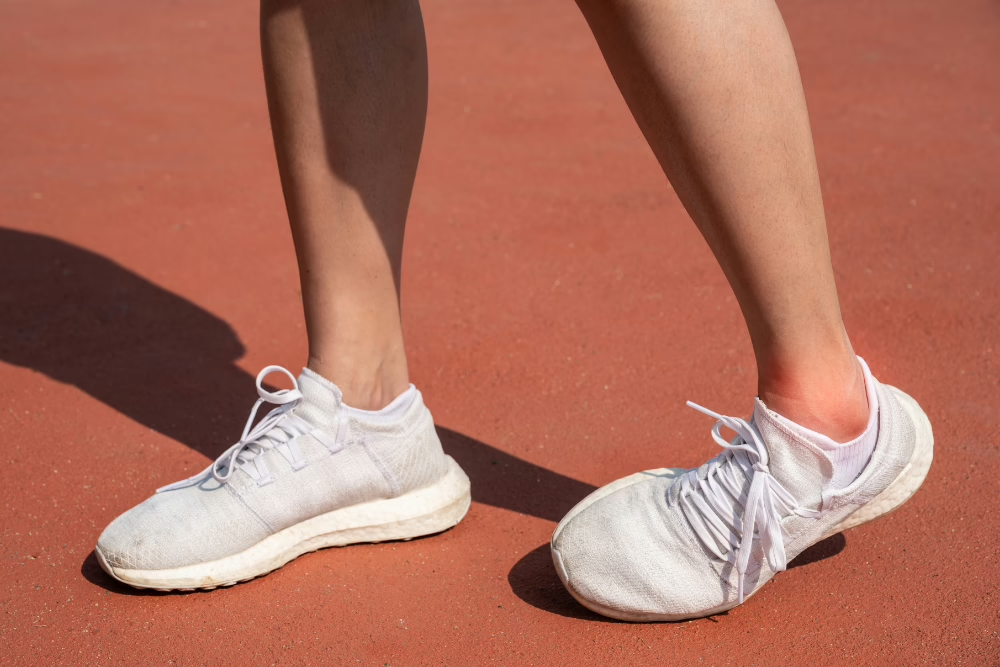Does your ankle frequently give out, even on flat surfaces?
Do you struggle with recurring sprains that make everyday activities and sports difficult? If so, you may be dealing with chronic ankle instability.
While most ankle sprains heal without long-term issues, about 10 percent of individuals develop ankle instability. This occurs when the ligaments heal in a lengthened position, making the ankle prone to rolling and additional sprains. Athletes such as ballet dancers, who naturally have more flexible ligaments, are particularly at risk (Hospital for Special Surgery).
The good news? With the right treatment, exercises, and support, you can strengthen your ankle and prevent future injuries.
Why Does My Ankle Keep Rolling? Common Causes
Ankle rolling—when your foot unexpectedly turns outward—can be caused by:
- Previous ankle sprains that have stretched or torn ligaments, leading to weakness
- Chronic ankle instability from repeated injuries
- Weak muscles and poor balance, reducing the body’s ability to stabilize
- Improper footwear that fails to support the ankle
Related Reading:
Learn more about ankle pain and its causes
Runners: Here’s why your ankle hurts while running
Signs of Chronic Ankle Instability
You may have chronic ankle instability if you experience:
- Frequent rolling of the ankle, even on level surfaces
- Persistent pain or swelling in the ankle
- A feeling of weakness or “giving way” when walking or exercising
- Recurring ankle sprains, sometimes from minor movements
If these symptoms sound familiar, a consultation with a foot and ankle specialist can help identify the best course of action.
How to Strengthen Your Ankle and Prevent Rolling
The most effective way to stop your ankle from rolling is through strengthening exercises, supportive footwear, and targeted treatments.
1. Strengthening Exercises for Ankle Stability
Building strength in the muscles surrounding your ankle improves stability and reduces the risk of injury. Recommended exercises include:
- Calf raises
- Ankle circles
- Resistance band exercises
- Balance drills such as standing on one foot
2. The Right Footwear Matters
Supportive shoes are essential for preventing ankle rolling. Look for:
- Good arch and ankle support
- A secure fit that minimizes movement inside the shoe
- Footwear designed for your specific activity (running, hiking, daily wear)
Learn more about picking good footwear.
3. Bracing or Taping for Extra Support
If you have a history of ankle sprains, consider wearing a brace or tape during physical activity. This provides additional support and helps prevent rolling.
4. See a Specialist for a Custom Treatment Plan
A podiatrist or orthopedic specialist can provide:
- A diagnosis of any underlying issues contributing to instability
- A physical therapy plan tailored to strengthen your ankle
- Recommendations for bracing, orthotics, or other treatments
5. Treat Ankle Sprains Properly
If you have recently suffered a sprain, follow the RICE method (Rest, Ice, Compression, Elevation) to reduce swelling and aid recovery. If pain persists, further medical intervention may be necessary.
When to See a Doctor
If your ankle continues to roll despite precautions, it is time to seek professional care. Chronic ankle instability can lead to long-term joint damage if untreated. A doctor may recommend physical therapy, bracing, or surgery in severe cases.
Find Expert Ankle Care in Colorado
Orthopaedic & Spine Center of the Rockies (OCR) has multiple locations throughout Northern Colorado and dedicated specialists who take care of patients with foot and ankle concerns every day. Whether you need a consultation for chronic ankle instability or ankle injuries, our physicians can help you with diagnosis and treatment options.
Stop the Cycle of Ankle Injuries – Get Help Today
Weak, unstable ankles do not have to limit your mobility. With the right exercises, footwear, and professional care, you can strengthen your ankle and prevent future sprains.
If your ankle keeps rolling, and you are ready for lasting relief, do not wait. Schedule an appointment with an orthopedic specialist today and take the first step toward stronger, more stable ankles.


